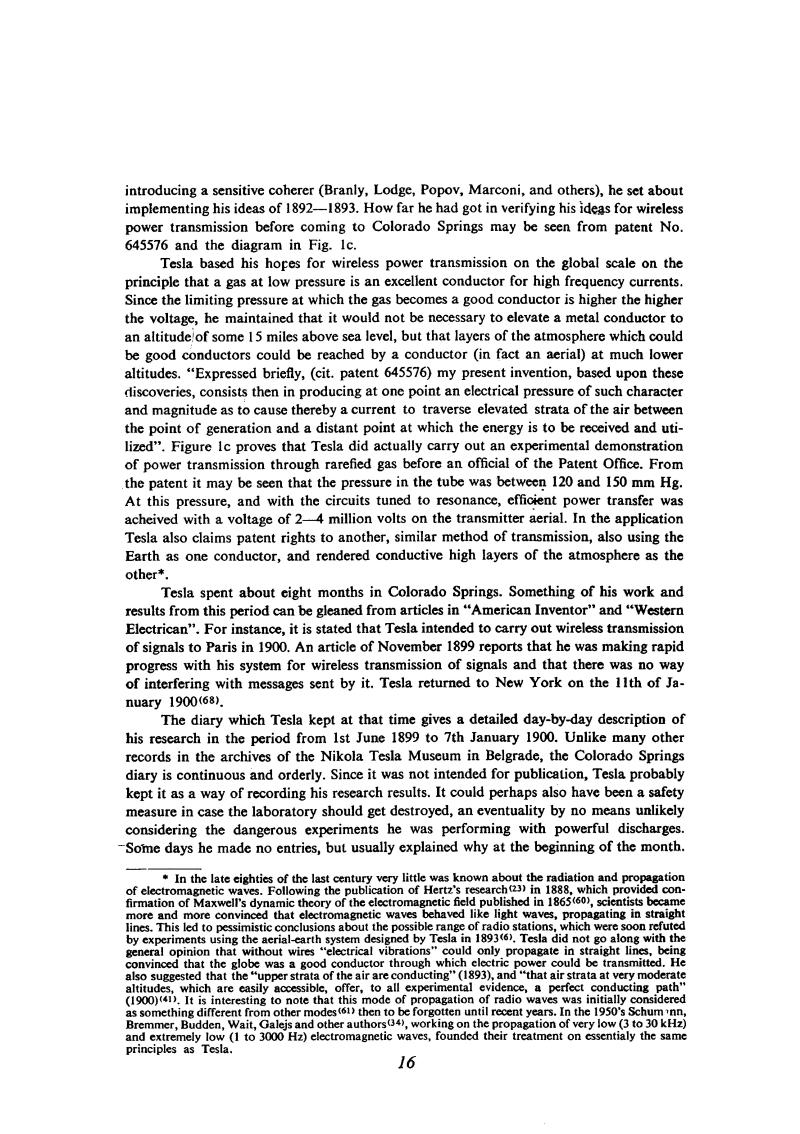
Nikola Tesla Books
introducing a sensitive coherer (Branly, Lodge, Popov, Marconi, and others), he set about implementing his ideas of 1892 - 1893. How far he had got in verifying his ideas for wireless power transmission before coming to Colorado Springs may be seen from patent No. 645576 and the diagram in Fig. 1c.
Tesla based his hopes for wireless power transmission on the global scale on the principle that a gas at low pressure is an excellent conductor for high frequency currents. Since the limiting pressure at which the gas becomes a good conductor is higher the higher the voltage, he maintained that it would not be necessary to elevate a metal conductor to an altitude of some 15 miles above sea level, but that layers of the atmosphere which could be good conductors could be reached by a conductor (in fact an aerial) at much lower altitudes. âExpressed briefly, (cit. patent 645576) my present invention, based upon these discoveries, consists then in producing at one point an electrical pressure of such character and magnitude as to cause thereby a current to traverse elevated strata of the air between the point of generation and a distant point at which the energy is to be received and utilizedâ. Figure 1c proves that Tesla did actually carry out an experimental demonstration of power transmission through rarefied gas before an official of the Patent Office. From the patent it may be seen that the pressure in the tube was between 120 and 150 mm Hg. At this pressure, and with the circuits tuned to resonance, efficient power transfer was acheived with a voltage of 2 - 4 million volts on the transmitter aerial. In the application Tesla also claims patent rights to another, similar method of transmission, also using the Earth as one conductor, and rendered conductive high layers of the atmosphere as the other*.
Tesla spent about eight months in Colorado Springs. Something of his work and results from this period can be gleaned from articles in âAmerican Inventorâ and âWestern Electricanâ. For instance, it is stated that Tesla intended to carry out wireless transmission of signals to Paris in 1900. An article of November 1899 reports that he was making rapid progress with his system for wireless transmission of signals and that there was no way of interfering with messages sent by it. Tesla returned to New York on the 11th of January 1900(68).
The diary which Tesla kept at that time gives a detailed day-by-day description of his research in the period from 1st June 1899 to 7th January 1900. Unlike many other records in the archives of the Nikola Tesla Museum in Belgrade, the Colorado Springs diary is continuous and orderly. Since it was not intended for publication, Tesla probably kept it as a way of recording his research results. It could perhaps also have been a safety measure in case the laboratory should get destroyed, an eventuality by no means unlikely considering the dangerous experiments he was performing with powerful discharges. Some days he made no entries, but usually explained why at the beginning of the month.
* In the late eighties of the last century very little was known about the radiation and propagation of electromagnetic waves. Following the publication of Hertz's research(23) in 1888, which provided confirmation of Maxwell's dynamic theory of the electromagnetic field published in 1865(60), scientists became more and more convinced that electromagnetic waves behaved like light waves, propagating in straight lines. This led to pessimistic conclusions about the possible range of radio stations, which were soon refuted by experiments using the aerial-earth system designed by Tesla in 1893(6). Tesla did not go along with the general opinion that without wires âelectrical vibrationsâ could only propagate in straight lines, being convinced that the globe was a good conductor through which electric power could be transmitted. He also suggested that the âupper strata of the air are conductingâ (1893), and âthat air strata at very moderate altitudes, which are easily accessible, offer, to all experimental evidence, a perfect conducting pathâ(1900)(41). It is interesting to note that this mode of propagation of radio waves was initially considered as something different from other modes(61) then to be forgotten until recent years. In the 1950's Schumann, Bremmer, Budden, Wait, Galejs and other authors(34), working on the propagation of very low (3 to 30 kHz) and extremely low (1 to 3000 Hz) electromagnetic waves, founded their treatment on essentially the same principles as Tesla.
16
Tesla: âOn light and other high frequency phenomenaâ, a lecture delivered before the Franklin Ins. Philadelphia, Febr. 1893, L-107.
Hertz, H.R. UNTERSUCHUNGEN UBER DIE AUSBREITUNG DER ELEKTRISCHEN KRAFT, dritte auflage, Leipzig, 1914, Johann Ambrosius Barth.
Galeys J. TERRESTRIAL PROPAGATION OF LONG ELECTROMAGNETIC WAVES, New York, Pergamon Press, 1972.
Tesla: âThe problem of increasing human energyâ, The Cent. Illustr. Mon. Magazine, June 1900, A-109.
Maxwell J.C. âA dynamical theory of the electromagnetic fieldâ, Phyl. Trans. Roy. Soc., 1865, vol. 155, p. 419.
Erskine-Murray J. A HANDBOOK OF WIRELESS TELEGRAPHY, Crosby Lockwood, London, 1913, chap. XVII.
Testimony in behalf of Tesla, Interference No. 21,701, United States Patent Office, New York, 1902.

